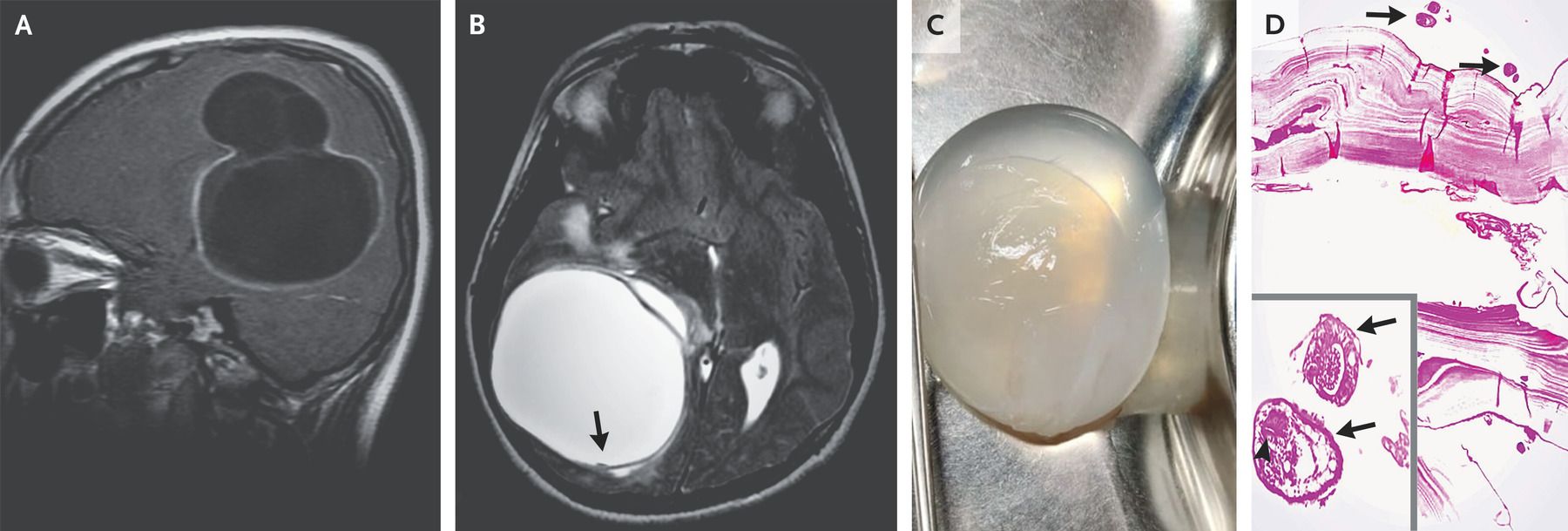Today's medical gross-out
-
Well...
Echinococcosis is a parasitic disease of tapeworms of the Echinococcus type...In the human manifestation of the disease, E. granulosus, E. multilocularis, E. oligarthrus and E. vogeli are localized in the liver (in 75% of cases), the lungs (in 5–15% of cases) and other organs in the body such as the spleen, brain, heart, and kidneys (in 10–20% of cases). In people who are infected with E. granulosus and therefore have cystic echinococcosis, the disease develops as a slow-growing mass in the body. These slow-growing masses, often called cysts, are also found in people that are infected with alveolar and polycystic echinococcosis.
The cysts found in those with cystic echinococcosis are usually filled with a clear fluid called hydatid fluid, are spherical, and typically consist of one compartment and are usually only found in one area of the body. While the cysts found in those with alveolar and polycystic echinococcosis are similar to those found in those with cystic echinococcosis, the alveolar and polycystic echinococcosis cysts usually have multiple compartments and have infiltrative as opposed to expansive growth.
I've seen at least two of these cases of intra-cerebral echinococcal cysts. One patient had multiple cysts, each about 1 cm in diameter. AFAIK, there was a full recovery.
-
@Jolly said in Today's medical gross-out:
Saline? And it just rolls out on its own? No other instruments?
Yup. Just get under it and it pops out.
@George-K said in Today's medical gross-out:
@Jolly said in Today's medical gross-out:
Saline? And it just rolls out on its own? No other instruments?
Yup. Just get under it and it pops out.
Nice that it does not "stick" to other tissues.
-
I ate a live octopus on the beach in Korea. "Supposedly" a delicacy. I am not a drinker, but had to fortify myself with some before doing it!! I guess a few people every year die doing this. Fortunately not me!
Go to ~ 4o sec to see it done.
Link to video
-
I ate a live octopus on the beach in Korea. "Supposedly" a delicacy. I am not a drinker, but had to fortify myself with some before doing it!! I guess a few people every year die doing this. Fortunately not me!
Go to ~ 4o sec to see it done.
Link to video
@taiwan_girl said in Today's medical gross-out:
I ate a live octopus on the beach in Korea. "Supposedly" a delicacy. I am not a drinker, but had to fortify myself with some before doing it!! I guess a few people every year die doing this. Fortunately not me!
Go to ~ 4o sec to see it done.
This should be in the "Nope" thread.
-
Oh, speaking of those brain cysts...
We were doing a case with a patient who had about half a dozen of these in her brain. During one part of the case, as the surgeon was removing the cysts, the circulating nurse was standing very close to the neurosurgeon.
As he teased another one out of the brain, he feigned dropping one and turned to the nurse, yelling "OOPS! THERE'S ANOTHER ONE!!"
She practically shat herself.
It was quite funny, but you probably had to be there.
-
This week's NEJM: Cerebral Cystic Echinococcosis
A previously healthy 14-year-old boy who lived on a farm presented with a 1-month history of episodic headaches associated with vomiting. Physical examination was notable for papilledema. Magnetic resonance imaging of the head showed a multiloculated cyst measuring 6.0 cm by 6.2 cm by 5.8 cm in the right temporoparietal region of the brain (Panel A, sagittal view, T1-weighted) with a hypointense rim and small projections in T2 phase (Panel B, axial view, arrow), findings suggestive of cystic echinococcosis. Computed tomography of the body showed no other sites of disease. A craniotomy was performed to excise the cyst. Saline irrigation was used to separate the cyst wall from the brain to avoid rupture (Panel C and video). Histopathological examination revealed an echinococcal laminated membrane lined by a germinal layer with daughter cysts (Panel D, arrows) and protoscolices (inset, arrows) with hooklets (arrowhead). A diagnosis of primary cerebral cystic echinococcosis from Echinococcus granulosus was made. Echinococcal cysts — also called hydatid cysts — most commonly form in the liver. The infection is transmitted to humans through contact with infected livestock or canine feces, as was likely to have happened in this case. Symptoms evolve if the cysts exert a mass effect. A 3-month course of albendazole was prescribed at discharge. At the 2-week follow-up, the patient’s symptoms had resolved.

This case is the one with the video I posted earlier.
"A previously healthy 14-year-old boy presented with episodic headaches associated with vomiting. Magnetic resonance imaging showed a multiloculated cyst in the right temporoparietal region of the brain. A craniotomy was performed, during which saline irrigation was used to separate the cyst wall from the brain to avoid rupture."

